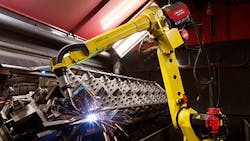The conventional wisdom holds that robots ultimately cost the jobs of the human beings they replace, and lead to an overall decline in manufacturing employment.
In a globalized economy, however, using robots might be one of the best ways for U.S. manufacturing jobs to live, thrive and survive.
Because of lower costs from abroad, there is a continuous push to find ways to save American factories and all the benefits they provide the U.S. economy.
One case that provides evidence how this can be done involves the cost of manual arc welding- a mainstay of manufacturing.
In one recent study conducted, the cost to manually arc weld a small part in the U.S. is about 84 cents, including labor and material. The same part in China costs only 40 cents. So, with such a huge discrepancy, how can U.S. manufacturers compete?
Robots have been a big part of the answer.
Cleveland-based Lincoln Electric Automation has been developing customized welding robots for U.S. manufacturers over the past many years. By being able to introduce Lincoln’s robot systems, customers have improved quality and productivity, while preserving the manufacturer’s U.S. factory. This has saved jobs and allowed American manufacturers to expand their operations - and hiring here at home.
This past week, to further complement these efforts, Lincoln announced plans to invest about $30 million in a new Welding Technology Center on its campus. Groundbreaking is expected to start in early 2016. The center, expected to open in 2017, will focus on training welding educators and industry leaders.
Some of you might be familiar with the Little Giant ladders manufactured by Wing Enterprises, Inc. in Springville, Utah. When the company’s sales increased through infomercials a few years back, strains on the production process appeared.
To deal with rising demand, Wing Enterprises acquired welding robot systems from Lincoln. Productivity increased 30% according to Brian Nielsen, an automated fusion technician with Wing. This helped Wing to build a new facility three times its original size and expand from 20 to 400 employees.
Further, Crown Equipment, the Greencastle, Indiana-based manufacturer of electric fork trucks, acquired three Lincoln robot systems to make specialized parts that created a new market for the company. This provided the foundation for an expansion that increased the company’s total number of employees from 200 to 335.
These examples illustrate that properly implementing technology like robots to support corporate strategy can ultimately lead to reduced costs, improved productivity, operational efficiency- and employment gains.
About the Author
Andrew R. Thomas
Bestselling business author & associate professor of marketing and international business
Andrew R. Thomas' most recent book is The Canal of Panama and Globalization: Growth and Challenges in the 21st Century (2022). He is an associate professor of marketing and international business at the University of Akron.
A successful global entrepreneur, Dr. Thomas was a principal in the first firm to ever export motor vehicles from China. He has traveled to and conducted business in 120 countries on all seven continents.
